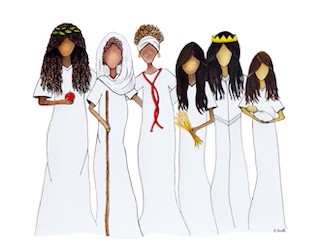Influential Women in Early Church History: Part 5 – Mary

Article 5 of 5

By Rev. Dr. Jackie Roese
Founder and President of The Marcella Project
www.themarcellaproject.com
This article is part of the series Pursuing Partnership: Men and Women in Ministry.
Mary, the Mother of Jesus and a First-Century Leader in the Church
I’ve been on a journey to learn the names of the hidden women in Scripture and reclaim their stories. Stories like Mary, the Mother of Jesus. Until recently, I’ve only heard of her as a mother and seen images of her with her head down, exhibiting meekness. But I’ve learned that Mary was not only a mother but a leader in the early Church. Learning a fuller story about women in the early Church is more accessible now than ten years ago. We have more women in seminaries, particularly conservative evangelical seminaries. That has led to more research coming out of academia from women asking questions that men haven’t asked. For example, a Dallas Theological Seminary professor, Dr. Glahn, grew up believing that motherhood was a woman’s primary role. And if she had the teaching gift, she would use it by instructing her kids. And Paul’s statement in 1 Tim. 2, “Women will be saved by childbirth,” proved it. But Dr. Glahn couldn’t have kids. And she had the gift of teaching. She was in a spiritual crisis. What was the point of her life? She needed to understand Paul. She spent the next decade researching the inscriptions, ancient literary sources, epigraphic evidence, architecture, and arts to understand what Paul meant. You’ll have to read her new book, Nobody’s Mother, but her work sheds new light on Artemis, the Goddess of Ephesus, and what Paul might mean in 1 Tim. 2. I want to emphasize that this isn’t feminism infiltrating our seminaries. Dr. Glahn is a conservative evangelical with a high view of Scripture. She didn’t expect to land where she did, but as she says, it’s where the evidence took her. More women in seminary asking different questions leads to a fuller understanding of our Christian faith.
And now that we have the internet, we can assess these kinds of sources and research in unprecedented ways. Discoveries continue to inform the context of the Bible and shape our understanding of it. For example, recently, they discovered this mosaic in the apse of the central dome of the Lateran Baptistery in Rome. It’s a 4th-century mosaic of Jesus at the top and then a line of people below. Mary is in the middle of the line with the apostle Paul to her left and Peter to her right. Mary can be seen with her arms in the orans pose, “lifting up holy hands” (1 Tim. 2:8). This is a sign of authority in the Church.
Dr. Scot McKnight, Professor at Northern Seminary in Chicago, argues that Mary was a leader in the early Church. He quotes Acts 1:14 to say that Mary was in the inner circle of power; her name was mentioned, indicating her importance in the group. He argues Jesus and James learned from their mother. Scripture says, “Jesus grew in wisdom and stature.” McKnight states, “Christians suggest that Jesus was inordinately precocious, knowing everything at birth and needing no instruction. Yet that isn’t what the Bible says. Luke says that Jesus grew and developed…. If Jesus was fully human, he succeeded as we grew, learned as we learn, and developed as we develop.”
And we know much of what we know from our parents. McKnight points out that we must read Mary’s Magnificat to discover the uncanny similarities between what God revealed to Mary and the central themes of Jesus’ mission. Where do you think Jesus learned those things?” He says James’ letter also has similarities with Mary’s Magnificat. Such as his “Blessings to the poor and stern warnings to the rich. He emphasized “mercy, faith, humility, peace, and wisdom.” James reintroduced pure Magnificat. This is probably the message he heard at home his entire life.”
Mary is mentioned in 217 verses in the New Testament, and several of the stories we have in the New Testament are Mary’s memoirs. After all, Mary was Jesus’ mom, and she knew, heard, and saw things that others weren’t privy to. Like the angel Gabriel proclaiming the virgin birth, and Elizabeth’s prophecy, the Magnificat, Simeon and Anna’s prophecy, Jesus turning water into wine. These are stories Mary would have known. And what do mothers do? They talk about their kids. McKnight argues Mary was a leader in the early Church.
But I also argue that Mary also preached. In the New Testament, the words preach and teach are used interchangeably. In a boat on Tuesday or a synagogue on Saturday. The most common usage refers to a heralding message on behalf of a king or person of authority. Mary did that in Luke 1:46-55. She is the first in Luke’s Gospel to proclaim the good news. (vs. 52) She’s the first in Luke’s Gospel to interpret Scripture. She mentioned the “strength of his arm,” alluding to the Exodus story and God’s promise to Abraham. She explains what the Scriptures said and how it’s being fulfilled today. In Preaching, we call that exegesis and hermeneutics.
We tend to read the Magnificat at Christmas like some little girl’s hallmark card, but this is anything but. This is a Freedom Fighters song. She’s putting Herod and Caesar Augustus on notice. A new King is coming; his arrival will change the order of things. This was such a threatening song that in the 1980s, Guatemala restricted the public reading for fear it would inspire the oppressed to rise against the government. Mary is preaching the Good News; it was recorded in Scripture, and she’s been heralding it ever since.
Learning their names. It’s taken thirty years, but I know them now. I am grateful for their witness. I find comfort in standing on their shoulders, knowing they know what it’s like to be a woman doing kingdom work. We women have a long legacy of women who fought the good fight and won the prize. (1 Corinthians 9:24) May we hear the words they many heard before us, “Well done, my good and faithful servant. Well done.” (Matthew 25:21)
This article is submitted by Wendy Wilson of Missio Nexus and of Women’s Development Track. Women’s Development Track is a Missio Nexus member. Member organizations can provide content to the Missio Nexus website. See how by clicking here.




Responses